Post-Industrialization and Urban Space in Hollywood Horror Films
VerifiedAdded on 2023/06/09
|12
|4016
|499
AI Summary
This discussion highlights the key aspects of the post-industrialized cities that were and are still used in Hollywood films, out of these elements the best way this concept was used in films that had a suspenseful aspect to it such as science fiction, thriller and of course horror. These films utilized this concept to create a legacy that is appreciated by film critics and audiences throughout the world.
Contribute Materials
Your contribution can guide someone’s learning journey. Share your
documents today.
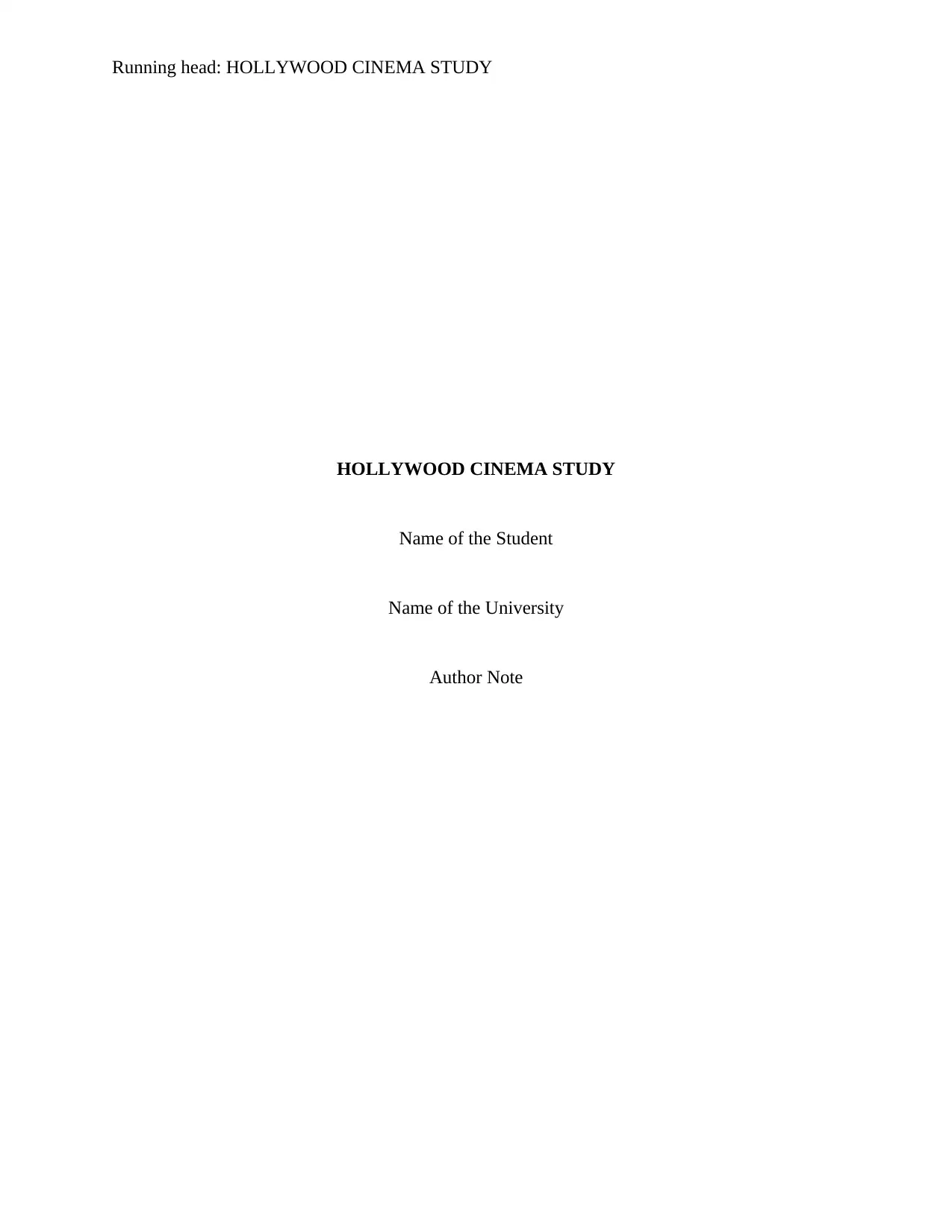
Running head: HOLLYWOOD CINEMA STUDY
HOLLYWOOD CINEMA STUDY
Name of the Student
Name of the University
Author Note
HOLLYWOOD CINEMA STUDY
Name of the Student
Name of the University
Author Note
Secure Best Marks with AI Grader
Need help grading? Try our AI Grader for instant feedback on your assignments.
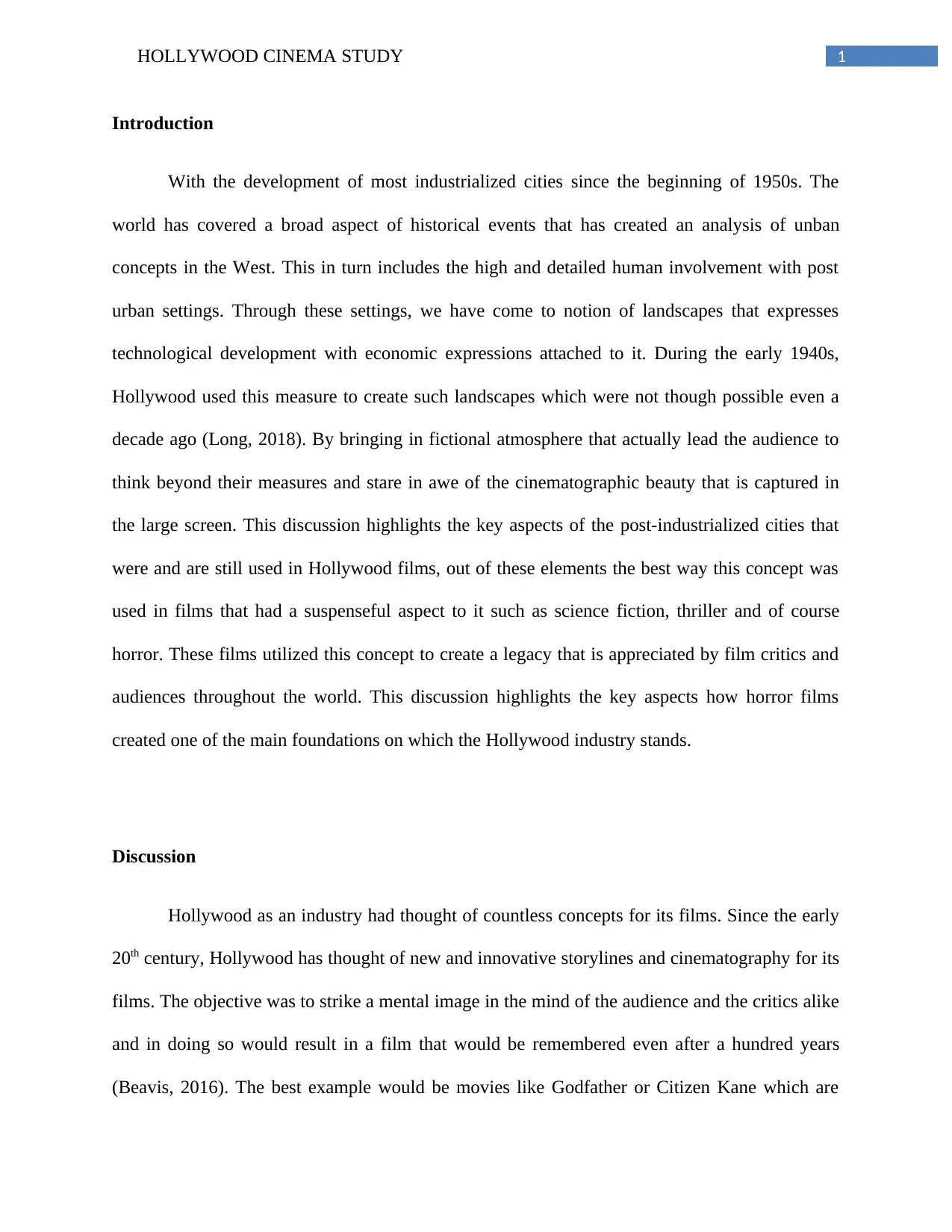
1HOLLYWOOD CINEMA STUDY
Introduction
With the development of most industrialized cities since the beginning of 1950s. The
world has covered a broad aspect of historical events that has created an analysis of unban
concepts in the West. This in turn includes the high and detailed human involvement with post
urban settings. Through these settings, we have come to notion of landscapes that expresses
technological development with economic expressions attached to it. During the early 1940s,
Hollywood used this measure to create such landscapes which were not though possible even a
decade ago (Long, 2018). By bringing in fictional atmosphere that actually lead the audience to
think beyond their measures and stare in awe of the cinematographic beauty that is captured in
the large screen. This discussion highlights the key aspects of the post-industrialized cities that
were and are still used in Hollywood films, out of these elements the best way this concept was
used in films that had a suspenseful aspect to it such as science fiction, thriller and of course
horror. These films utilized this concept to create a legacy that is appreciated by film critics and
audiences throughout the world. This discussion highlights the key aspects how horror films
created one of the main foundations on which the Hollywood industry stands.
Discussion
Hollywood as an industry had thought of countless concepts for its films. Since the early
20th century, Hollywood has thought of new and innovative storylines and cinematography for its
films. The objective was to strike a mental image in the mind of the audience and the critics alike
and in doing so would result in a film that would be remembered even after a hundred years
(Beavis, 2016). The best example would be movies like Godfather or Citizen Kane which are
Introduction
With the development of most industrialized cities since the beginning of 1950s. The
world has covered a broad aspect of historical events that has created an analysis of unban
concepts in the West. This in turn includes the high and detailed human involvement with post
urban settings. Through these settings, we have come to notion of landscapes that expresses
technological development with economic expressions attached to it. During the early 1940s,
Hollywood used this measure to create such landscapes which were not though possible even a
decade ago (Long, 2018). By bringing in fictional atmosphere that actually lead the audience to
think beyond their measures and stare in awe of the cinematographic beauty that is captured in
the large screen. This discussion highlights the key aspects of the post-industrialized cities that
were and are still used in Hollywood films, out of these elements the best way this concept was
used in films that had a suspenseful aspect to it such as science fiction, thriller and of course
horror. These films utilized this concept to create a legacy that is appreciated by film critics and
audiences throughout the world. This discussion highlights the key aspects how horror films
created one of the main foundations on which the Hollywood industry stands.
Discussion
Hollywood as an industry had thought of countless concepts for its films. Since the early
20th century, Hollywood has thought of new and innovative storylines and cinematography for its
films. The objective was to strike a mental image in the mind of the audience and the critics alike
and in doing so would result in a film that would be remembered even after a hundred years
(Beavis, 2016). The best example would be movies like Godfather or Citizen Kane which are
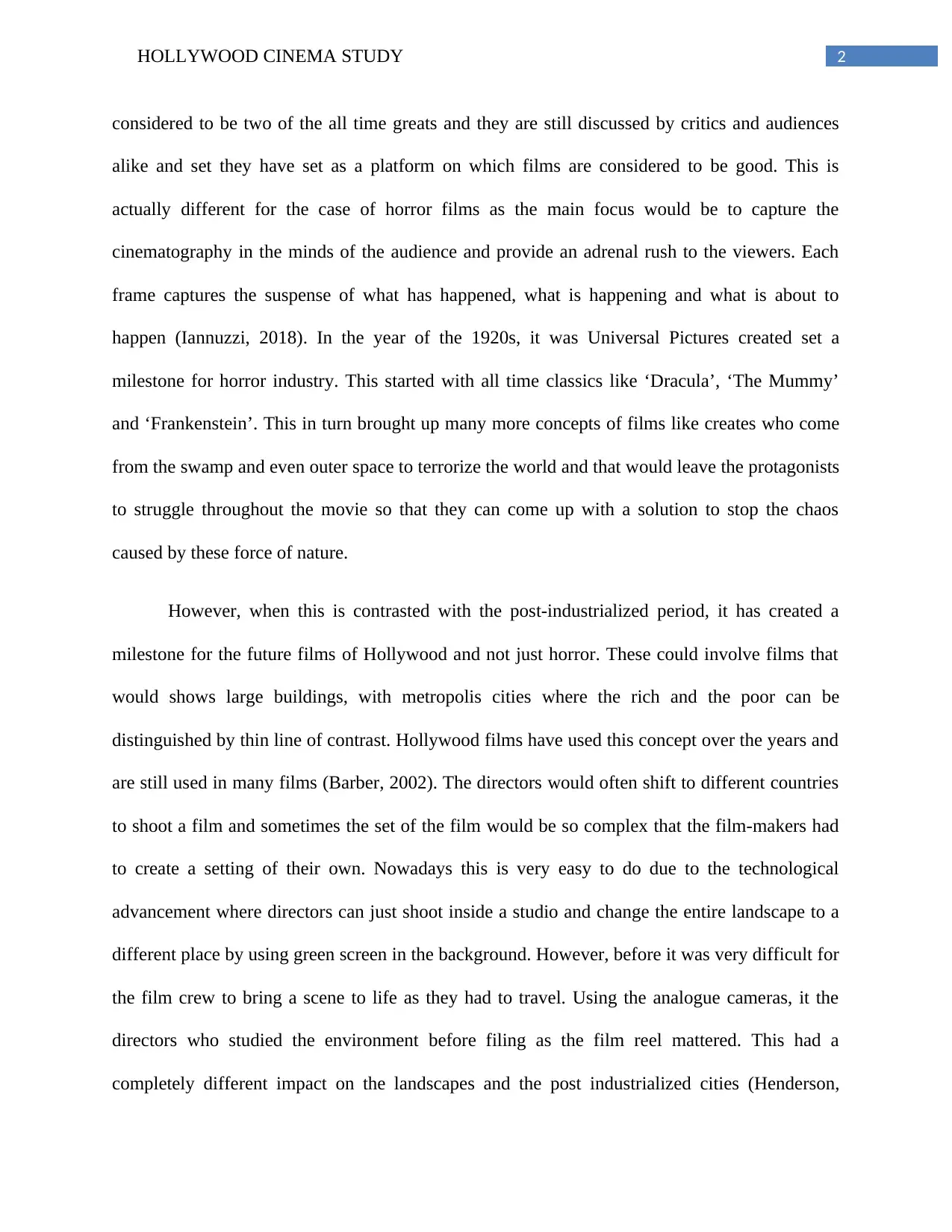
2HOLLYWOOD CINEMA STUDY
considered to be two of the all time greats and they are still discussed by critics and audiences
alike and set they have set as a platform on which films are considered to be good. This is
actually different for the case of horror films as the main focus would be to capture the
cinematography in the minds of the audience and provide an adrenal rush to the viewers. Each
frame captures the suspense of what has happened, what is happening and what is about to
happen (Iannuzzi, 2018). In the year of the 1920s, it was Universal Pictures created set a
milestone for horror industry. This started with all time classics like ‘Dracula’, ‘The Mummy’
and ‘Frankenstein’. This in turn brought up many more concepts of films like creates who come
from the swamp and even outer space to terrorize the world and that would leave the protagonists
to struggle throughout the movie so that they can come up with a solution to stop the chaos
caused by these force of nature.
However, when this is contrasted with the post-industrialized period, it has created a
milestone for the future films of Hollywood and not just horror. These could involve films that
would shows large buildings, with metropolis cities where the rich and the poor can be
distinguished by thin line of contrast. Hollywood films have used this concept over the years and
are still used in many films (Barber, 2002). The directors would often shift to different countries
to shoot a film and sometimes the set of the film would be so complex that the film-makers had
to create a setting of their own. Nowadays this is very easy to do due to the technological
advancement where directors can just shoot inside a studio and change the entire landscape to a
different place by using green screen in the background. However, before it was very difficult for
the film crew to bring a scene to life as they had to travel. Using the analogue cameras, it the
directors who studied the environment before filing as the film reel mattered. This had a
completely different impact on the landscapes and the post industrialized cities (Henderson,
considered to be two of the all time greats and they are still discussed by critics and audiences
alike and set they have set as a platform on which films are considered to be good. This is
actually different for the case of horror films as the main focus would be to capture the
cinematography in the minds of the audience and provide an adrenal rush to the viewers. Each
frame captures the suspense of what has happened, what is happening and what is about to
happen (Iannuzzi, 2018). In the year of the 1920s, it was Universal Pictures created set a
milestone for horror industry. This started with all time classics like ‘Dracula’, ‘The Mummy’
and ‘Frankenstein’. This in turn brought up many more concepts of films like creates who come
from the swamp and even outer space to terrorize the world and that would leave the protagonists
to struggle throughout the movie so that they can come up with a solution to stop the chaos
caused by these force of nature.
However, when this is contrasted with the post-industrialized period, it has created a
milestone for the future films of Hollywood and not just horror. These could involve films that
would shows large buildings, with metropolis cities where the rich and the poor can be
distinguished by thin line of contrast. Hollywood films have used this concept over the years and
are still used in many films (Barber, 2002). The directors would often shift to different countries
to shoot a film and sometimes the set of the film would be so complex that the film-makers had
to create a setting of their own. Nowadays this is very easy to do due to the technological
advancement where directors can just shoot inside a studio and change the entire landscape to a
different place by using green screen in the background. However, before it was very difficult for
the film crew to bring a scene to life as they had to travel. Using the analogue cameras, it the
directors who studied the environment before filing as the film reel mattered. This had a
completely different impact on the landscapes and the post industrialized cities (Henderson,
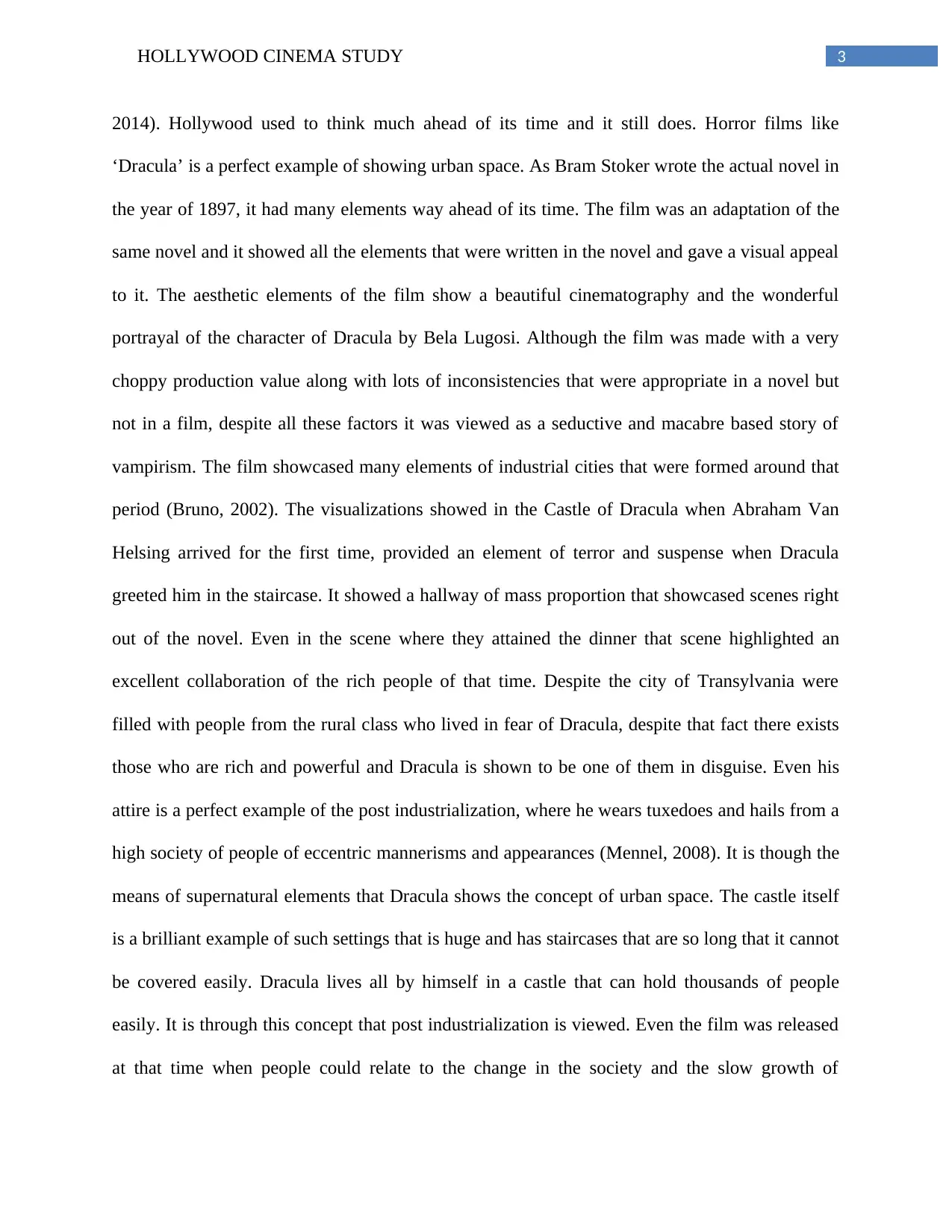
3HOLLYWOOD CINEMA STUDY
2014). Hollywood used to think much ahead of its time and it still does. Horror films like
‘Dracula’ is a perfect example of showing urban space. As Bram Stoker wrote the actual novel in
the year of 1897, it had many elements way ahead of its time. The film was an adaptation of the
same novel and it showed all the elements that were written in the novel and gave a visual appeal
to it. The aesthetic elements of the film show a beautiful cinematography and the wonderful
portrayal of the character of Dracula by Bela Lugosi. Although the film was made with a very
choppy production value along with lots of inconsistencies that were appropriate in a novel but
not in a film, despite all these factors it was viewed as a seductive and macabre based story of
vampirism. The film showcased many elements of industrial cities that were formed around that
period (Bruno, 2002). The visualizations showed in the Castle of Dracula when Abraham Van
Helsing arrived for the first time, provided an element of terror and suspense when Dracula
greeted him in the staircase. It showed a hallway of mass proportion that showcased scenes right
out of the novel. Even in the scene where they attained the dinner that scene highlighted an
excellent collaboration of the rich people of that time. Despite the city of Transylvania were
filled with people from the rural class who lived in fear of Dracula, despite that fact there exists
those who are rich and powerful and Dracula is shown to be one of them in disguise. Even his
attire is a perfect example of the post industrialization, where he wears tuxedoes and hails from a
high society of people of eccentric mannerisms and appearances (Mennel, 2008). It is though the
means of supernatural elements that Dracula shows the concept of urban space. The castle itself
is a brilliant example of such settings that is huge and has staircases that are so long that it cannot
be covered easily. Dracula lives all by himself in a castle that can hold thousands of people
easily. It is through this concept that post industrialization is viewed. Even the film was released
at that time when people could relate to the change in the society and the slow growth of
2014). Hollywood used to think much ahead of its time and it still does. Horror films like
‘Dracula’ is a perfect example of showing urban space. As Bram Stoker wrote the actual novel in
the year of 1897, it had many elements way ahead of its time. The film was an adaptation of the
same novel and it showed all the elements that were written in the novel and gave a visual appeal
to it. The aesthetic elements of the film show a beautiful cinematography and the wonderful
portrayal of the character of Dracula by Bela Lugosi. Although the film was made with a very
choppy production value along with lots of inconsistencies that were appropriate in a novel but
not in a film, despite all these factors it was viewed as a seductive and macabre based story of
vampirism. The film showcased many elements of industrial cities that were formed around that
period (Bruno, 2002). The visualizations showed in the Castle of Dracula when Abraham Van
Helsing arrived for the first time, provided an element of terror and suspense when Dracula
greeted him in the staircase. It showed a hallway of mass proportion that showcased scenes right
out of the novel. Even in the scene where they attained the dinner that scene highlighted an
excellent collaboration of the rich people of that time. Despite the city of Transylvania were
filled with people from the rural class who lived in fear of Dracula, despite that fact there exists
those who are rich and powerful and Dracula is shown to be one of them in disguise. Even his
attire is a perfect example of the post industrialization, where he wears tuxedoes and hails from a
high society of people of eccentric mannerisms and appearances (Mennel, 2008). It is though the
means of supernatural elements that Dracula shows the concept of urban space. The castle itself
is a brilliant example of such settings that is huge and has staircases that are so long that it cannot
be covered easily. Dracula lives all by himself in a castle that can hold thousands of people
easily. It is through this concept that post industrialization is viewed. Even the film was released
at that time when people could relate to the change in the society and the slow growth of
Secure Best Marks with AI Grader
Need help grading? Try our AI Grader for instant feedback on your assignments.
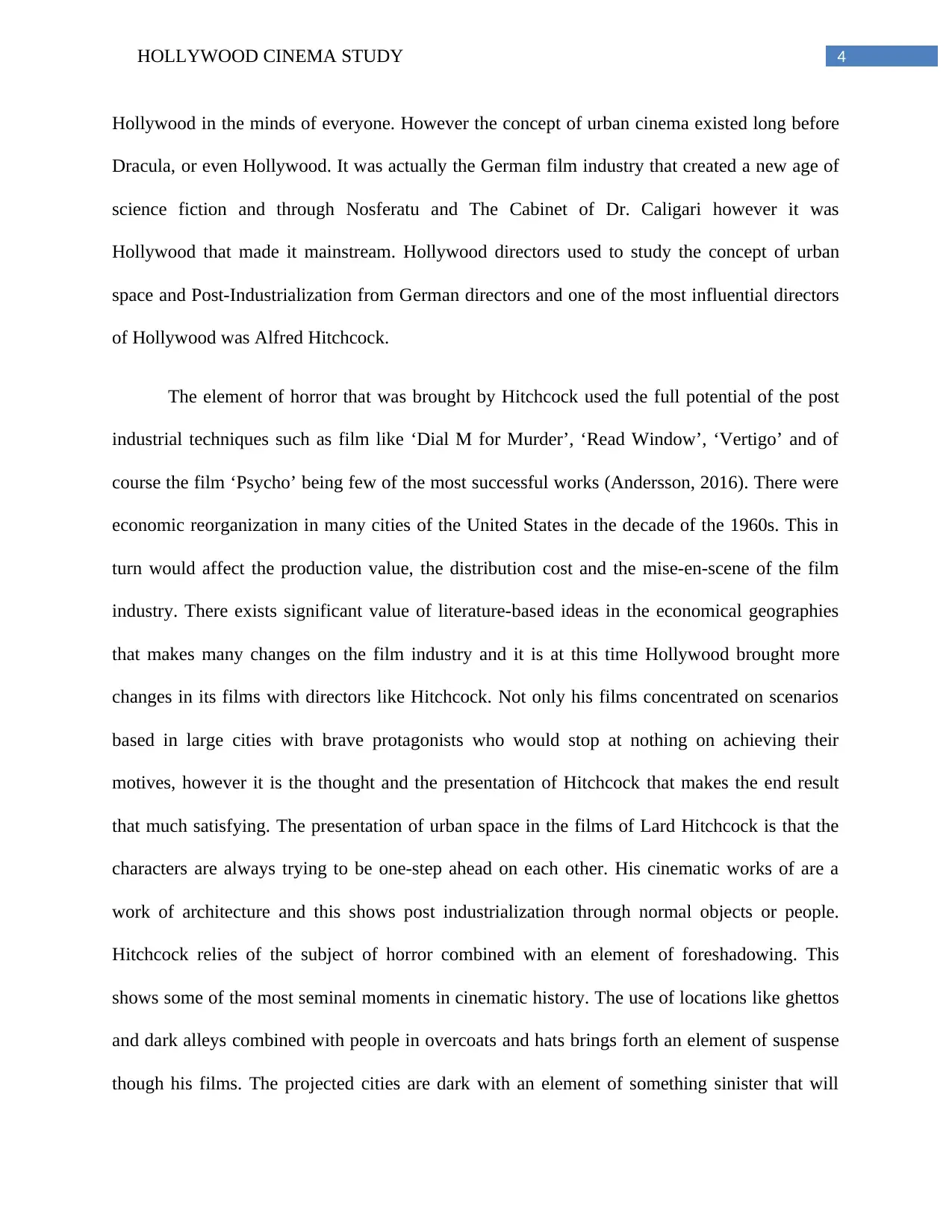
4HOLLYWOOD CINEMA STUDY
Hollywood in the minds of everyone. However the concept of urban cinema existed long before
Dracula, or even Hollywood. It was actually the German film industry that created a new age of
science fiction and through Nosferatu and The Cabinet of Dr. Caligari however it was
Hollywood that made it mainstream. Hollywood directors used to study the concept of urban
space and Post-Industrialization from German directors and one of the most influential directors
of Hollywood was Alfred Hitchcock.
The element of horror that was brought by Hitchcock used the full potential of the post
industrial techniques such as film like ‘Dial M for Murder’, ‘Read Window’, ‘Vertigo’ and of
course the film ‘Psycho’ being few of the most successful works (Andersson, 2016). There were
economic reorganization in many cities of the United States in the decade of the 1960s. This in
turn would affect the production value, the distribution cost and the mise-en-scene of the film
industry. There exists significant value of literature-based ideas in the economical geographies
that makes many changes on the film industry and it is at this time Hollywood brought more
changes in its films with directors like Hitchcock. Not only his films concentrated on scenarios
based in large cities with brave protagonists who would stop at nothing on achieving their
motives, however it is the thought and the presentation of Hitchcock that makes the end result
that much satisfying. The presentation of urban space in the films of Lard Hitchcock is that the
characters are always trying to be one-step ahead on each other. His cinematic works of are a
work of architecture and this shows post industrialization through normal objects or people.
Hitchcock relies of the subject of horror combined with an element of foreshadowing. This
shows some of the most seminal moments in cinematic history. The use of locations like ghettos
and dark alleys combined with people in overcoats and hats brings forth an element of suspense
though his films. The projected cities are dark with an element of something sinister that will
Hollywood in the minds of everyone. However the concept of urban cinema existed long before
Dracula, or even Hollywood. It was actually the German film industry that created a new age of
science fiction and through Nosferatu and The Cabinet of Dr. Caligari however it was
Hollywood that made it mainstream. Hollywood directors used to study the concept of urban
space and Post-Industrialization from German directors and one of the most influential directors
of Hollywood was Alfred Hitchcock.
The element of horror that was brought by Hitchcock used the full potential of the post
industrial techniques such as film like ‘Dial M for Murder’, ‘Read Window’, ‘Vertigo’ and of
course the film ‘Psycho’ being few of the most successful works (Andersson, 2016). There were
economic reorganization in many cities of the United States in the decade of the 1960s. This in
turn would affect the production value, the distribution cost and the mise-en-scene of the film
industry. There exists significant value of literature-based ideas in the economical geographies
that makes many changes on the film industry and it is at this time Hollywood brought more
changes in its films with directors like Hitchcock. Not only his films concentrated on scenarios
based in large cities with brave protagonists who would stop at nothing on achieving their
motives, however it is the thought and the presentation of Hitchcock that makes the end result
that much satisfying. The presentation of urban space in the films of Lard Hitchcock is that the
characters are always trying to be one-step ahead on each other. His cinematic works of are a
work of architecture and this shows post industrialization through normal objects or people.
Hitchcock relies of the subject of horror combined with an element of foreshadowing. This
shows some of the most seminal moments in cinematic history. The use of locations like ghettos
and dark alleys combined with people in overcoats and hats brings forth an element of suspense
though his films. The projected cities are dark with an element of something sinister that will
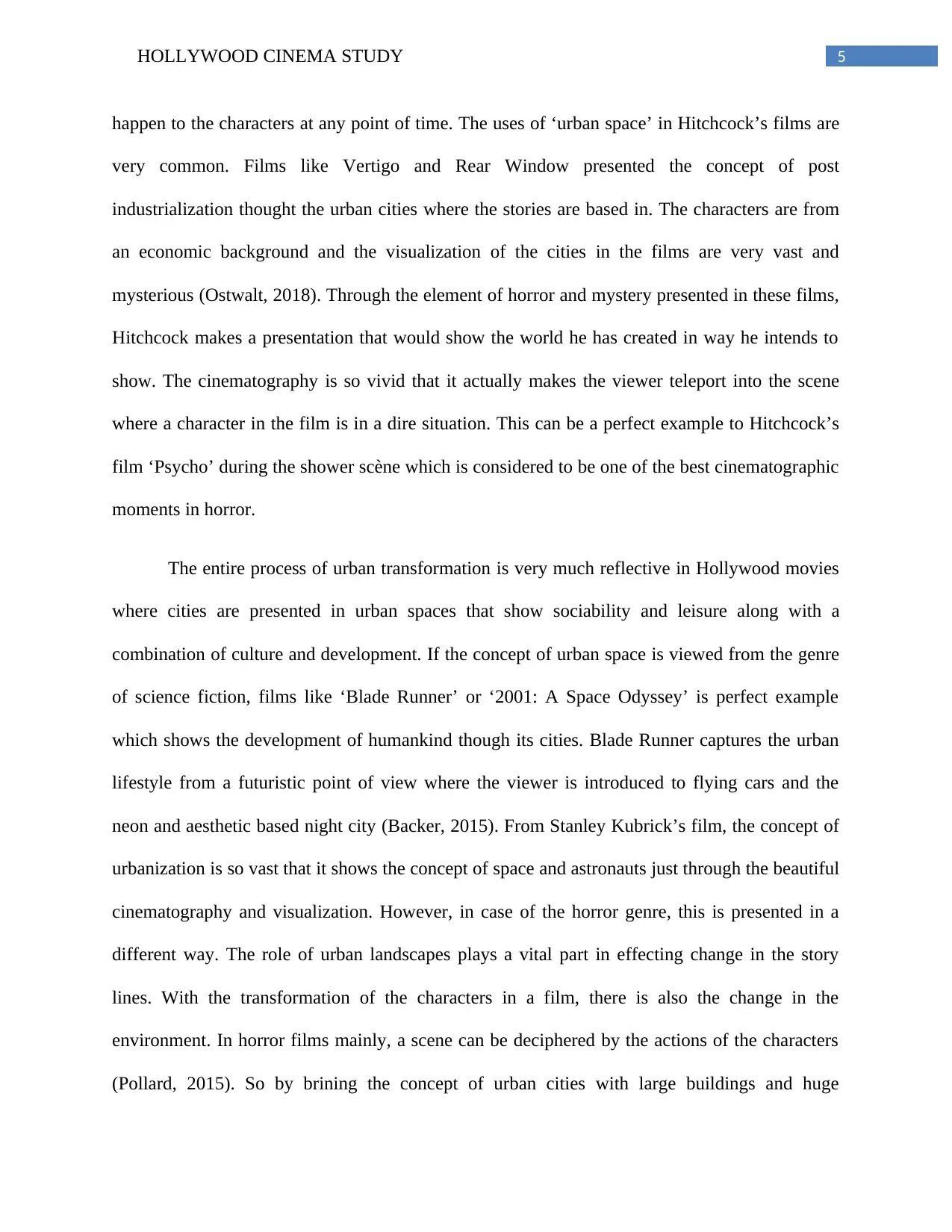
5HOLLYWOOD CINEMA STUDY
happen to the characters at any point of time. The uses of ‘urban space’ in Hitchcock’s films are
very common. Films like Vertigo and Rear Window presented the concept of post
industrialization thought the urban cities where the stories are based in. The characters are from
an economic background and the visualization of the cities in the films are very vast and
mysterious (Ostwalt, 2018). Through the element of horror and mystery presented in these films,
Hitchcock makes a presentation that would show the world he has created in way he intends to
show. The cinematography is so vivid that it actually makes the viewer teleport into the scene
where a character in the film is in a dire situation. This can be a perfect example to Hitchcock’s
film ‘Psycho’ during the shower scène which is considered to be one of the best cinematographic
moments in horror.
The entire process of urban transformation is very much reflective in Hollywood movies
where cities are presented in urban spaces that show sociability and leisure along with a
combination of culture and development. If the concept of urban space is viewed from the genre
of science fiction, films like ‘Blade Runner’ or ‘2001: A Space Odyssey’ is perfect example
which shows the development of humankind though its cities. Blade Runner captures the urban
lifestyle from a futuristic point of view where the viewer is introduced to flying cars and the
neon and aesthetic based night city (Backer, 2015). From Stanley Kubrick’s film, the concept of
urbanization is so vast that it shows the concept of space and astronauts just through the beautiful
cinematography and visualization. However, in case of the horror genre, this is presented in a
different way. The role of urban landscapes plays a vital part in effecting change in the story
lines. With the transformation of the characters in a film, there is also the change in the
environment. In horror films mainly, a scene can be deciphered by the actions of the characters
(Pollard, 2015). So by brining the concept of urban cities with large buildings and huge
happen to the characters at any point of time. The uses of ‘urban space’ in Hitchcock’s films are
very common. Films like Vertigo and Rear Window presented the concept of post
industrialization thought the urban cities where the stories are based in. The characters are from
an economic background and the visualization of the cities in the films are very vast and
mysterious (Ostwalt, 2018). Through the element of horror and mystery presented in these films,
Hitchcock makes a presentation that would show the world he has created in way he intends to
show. The cinematography is so vivid that it actually makes the viewer teleport into the scene
where a character in the film is in a dire situation. This can be a perfect example to Hitchcock’s
film ‘Psycho’ during the shower scène which is considered to be one of the best cinematographic
moments in horror.
The entire process of urban transformation is very much reflective in Hollywood movies
where cities are presented in urban spaces that show sociability and leisure along with a
combination of culture and development. If the concept of urban space is viewed from the genre
of science fiction, films like ‘Blade Runner’ or ‘2001: A Space Odyssey’ is perfect example
which shows the development of humankind though its cities. Blade Runner captures the urban
lifestyle from a futuristic point of view where the viewer is introduced to flying cars and the
neon and aesthetic based night city (Backer, 2015). From Stanley Kubrick’s film, the concept of
urbanization is so vast that it shows the concept of space and astronauts just through the beautiful
cinematography and visualization. However, in case of the horror genre, this is presented in a
different way. The role of urban landscapes plays a vital part in effecting change in the story
lines. With the transformation of the characters in a film, there is also the change in the
environment. In horror films mainly, a scene can be deciphered by the actions of the characters
(Pollard, 2015). So by brining the concept of urban cities with large buildings and huge
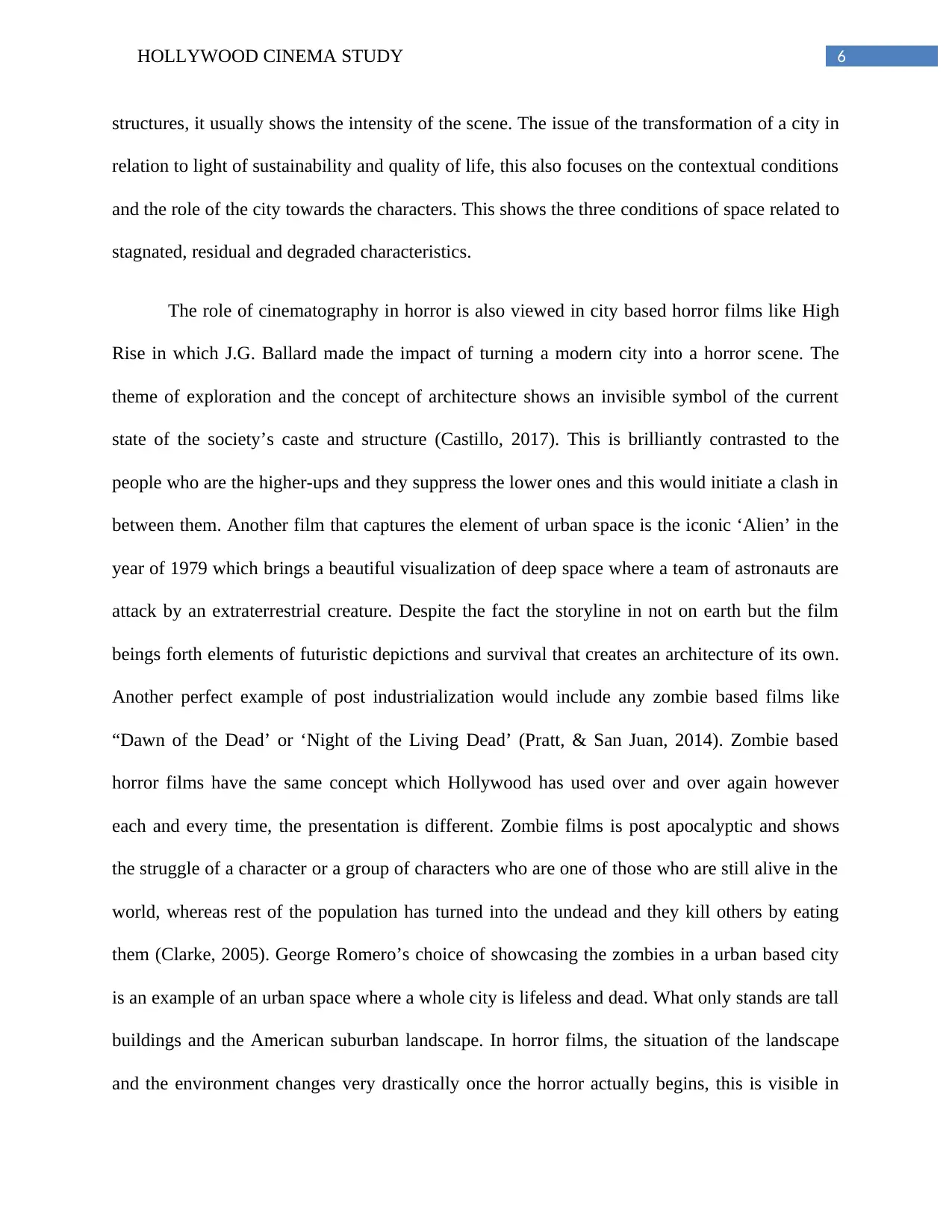
6HOLLYWOOD CINEMA STUDY
structures, it usually shows the intensity of the scene. The issue of the transformation of a city in
relation to light of sustainability and quality of life, this also focuses on the contextual conditions
and the role of the city towards the characters. This shows the three conditions of space related to
stagnated, residual and degraded characteristics.
The role of cinematography in horror is also viewed in city based horror films like High
Rise in which J.G. Ballard made the impact of turning a modern city into a horror scene. The
theme of exploration and the concept of architecture shows an invisible symbol of the current
state of the society’s caste and structure (Castillo, 2017). This is brilliantly contrasted to the
people who are the higher-ups and they suppress the lower ones and this would initiate a clash in
between them. Another film that captures the element of urban space is the iconic ‘Alien’ in the
year of 1979 which brings a beautiful visualization of deep space where a team of astronauts are
attack by an extraterrestrial creature. Despite the fact the storyline in not on earth but the film
beings forth elements of futuristic depictions and survival that creates an architecture of its own.
Another perfect example of post industrialization would include any zombie based films like
“Dawn of the Dead’ or ‘Night of the Living Dead’ (Pratt, & San Juan, 2014). Zombie based
horror films have the same concept which Hollywood has used over and over again however
each and every time, the presentation is different. Zombie films is post apocalyptic and shows
the struggle of a character or a group of characters who are one of those who are still alive in the
world, whereas rest of the population has turned into the undead and they kill others by eating
them (Clarke, 2005). George Romero’s choice of showcasing the zombies in a urban based city
is an example of an urban space where a whole city is lifeless and dead. What only stands are tall
buildings and the American suburban landscape. In horror films, the situation of the landscape
and the environment changes very drastically once the horror actually begins, this is visible in
structures, it usually shows the intensity of the scene. The issue of the transformation of a city in
relation to light of sustainability and quality of life, this also focuses on the contextual conditions
and the role of the city towards the characters. This shows the three conditions of space related to
stagnated, residual and degraded characteristics.
The role of cinematography in horror is also viewed in city based horror films like High
Rise in which J.G. Ballard made the impact of turning a modern city into a horror scene. The
theme of exploration and the concept of architecture shows an invisible symbol of the current
state of the society’s caste and structure (Castillo, 2017). This is brilliantly contrasted to the
people who are the higher-ups and they suppress the lower ones and this would initiate a clash in
between them. Another film that captures the element of urban space is the iconic ‘Alien’ in the
year of 1979 which brings a beautiful visualization of deep space where a team of astronauts are
attack by an extraterrestrial creature. Despite the fact the storyline in not on earth but the film
beings forth elements of futuristic depictions and survival that creates an architecture of its own.
Another perfect example of post industrialization would include any zombie based films like
“Dawn of the Dead’ or ‘Night of the Living Dead’ (Pratt, & San Juan, 2014). Zombie based
horror films have the same concept which Hollywood has used over and over again however
each and every time, the presentation is different. Zombie films is post apocalyptic and shows
the struggle of a character or a group of characters who are one of those who are still alive in the
world, whereas rest of the population has turned into the undead and they kill others by eating
them (Clarke, 2005). George Romero’s choice of showcasing the zombies in a urban based city
is an example of an urban space where a whole city is lifeless and dead. What only stands are tall
buildings and the American suburban landscape. In horror films, the situation of the landscape
and the environment changes very drastically once the horror actually begins, this is visible in
Paraphrase This Document
Need a fresh take? Get an instant paraphrase of this document with our AI Paraphraser
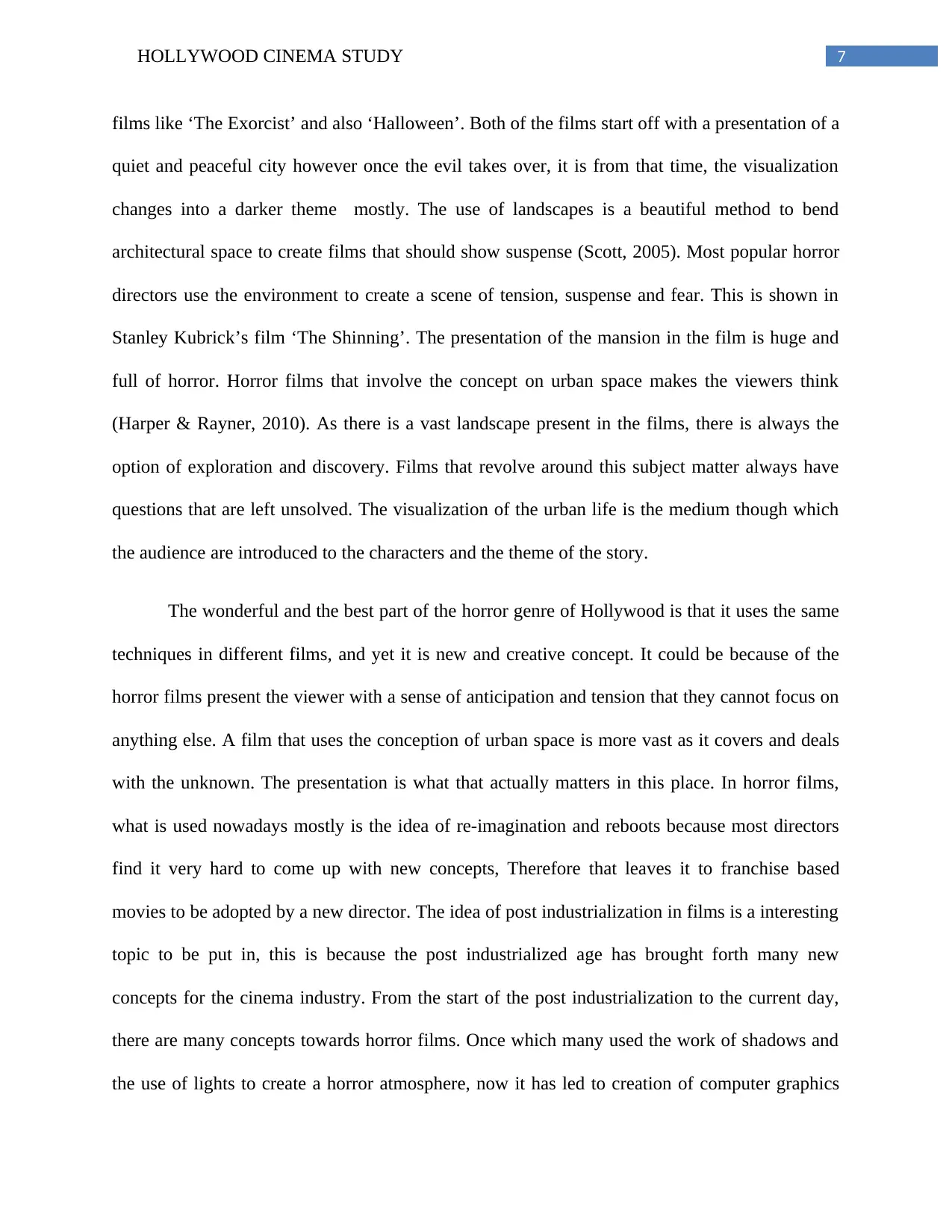
7HOLLYWOOD CINEMA STUDY
films like ‘The Exorcist’ and also ‘Halloween’. Both of the films start off with a presentation of a
quiet and peaceful city however once the evil takes over, it is from that time, the visualization
changes into a darker theme mostly. The use of landscapes is a beautiful method to bend
architectural space to create films that should show suspense (Scott, 2005). Most popular horror
directors use the environment to create a scene of tension, suspense and fear. This is shown in
Stanley Kubrick’s film ‘The Shinning’. The presentation of the mansion in the film is huge and
full of horror. Horror films that involve the concept on urban space makes the viewers think
(Harper & Rayner, 2010). As there is a vast landscape present in the films, there is always the
option of exploration and discovery. Films that revolve around this subject matter always have
questions that are left unsolved. The visualization of the urban life is the medium though which
the audience are introduced to the characters and the theme of the story.
The wonderful and the best part of the horror genre of Hollywood is that it uses the same
techniques in different films, and yet it is new and creative concept. It could be because of the
horror films present the viewer with a sense of anticipation and tension that they cannot focus on
anything else. A film that uses the conception of urban space is more vast as it covers and deals
with the unknown. The presentation is what that actually matters in this place. In horror films,
what is used nowadays mostly is the idea of re-imagination and reboots because most directors
find it very hard to come up with new concepts, Therefore that leaves it to franchise based
movies to be adopted by a new director. The idea of post industrialization in films is a interesting
topic to be put in, this is because the post industrialized age has brought forth many new
concepts for the cinema industry. From the start of the post industrialization to the current day,
there are many concepts towards horror films. Once which many used the work of shadows and
the use of lights to create a horror atmosphere, now it has led to creation of computer graphics
films like ‘The Exorcist’ and also ‘Halloween’. Both of the films start off with a presentation of a
quiet and peaceful city however once the evil takes over, it is from that time, the visualization
changes into a darker theme mostly. The use of landscapes is a beautiful method to bend
architectural space to create films that should show suspense (Scott, 2005). Most popular horror
directors use the environment to create a scene of tension, suspense and fear. This is shown in
Stanley Kubrick’s film ‘The Shinning’. The presentation of the mansion in the film is huge and
full of horror. Horror films that involve the concept on urban space makes the viewers think
(Harper & Rayner, 2010). As there is a vast landscape present in the films, there is always the
option of exploration and discovery. Films that revolve around this subject matter always have
questions that are left unsolved. The visualization of the urban life is the medium though which
the audience are introduced to the characters and the theme of the story.
The wonderful and the best part of the horror genre of Hollywood is that it uses the same
techniques in different films, and yet it is new and creative concept. It could be because of the
horror films present the viewer with a sense of anticipation and tension that they cannot focus on
anything else. A film that uses the conception of urban space is more vast as it covers and deals
with the unknown. The presentation is what that actually matters in this place. In horror films,
what is used nowadays mostly is the idea of re-imagination and reboots because most directors
find it very hard to come up with new concepts, Therefore that leaves it to franchise based
movies to be adopted by a new director. The idea of post industrialization in films is a interesting
topic to be put in, this is because the post industrialized age has brought forth many new
concepts for the cinema industry. From the start of the post industrialization to the current day,
there are many concepts towards horror films. Once which many used the work of shadows and
the use of lights to create a horror atmosphere, now it has led to creation of computer graphics
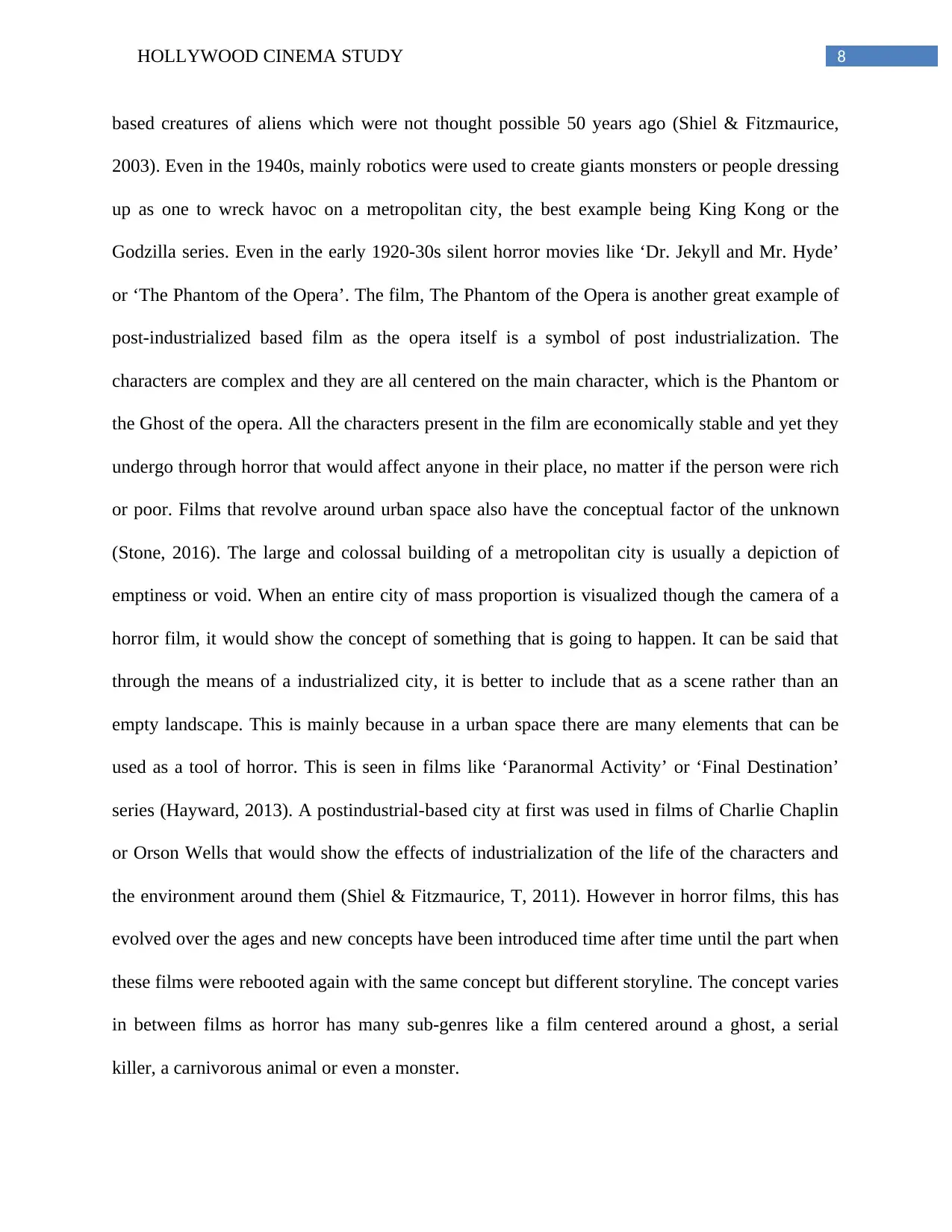
8HOLLYWOOD CINEMA STUDY
based creatures of aliens which were not thought possible 50 years ago (Shiel & Fitzmaurice,
2003). Even in the 1940s, mainly robotics were used to create giants monsters or people dressing
up as one to wreck havoc on a metropolitan city, the best example being King Kong or the
Godzilla series. Even in the early 1920-30s silent horror movies like ‘Dr. Jekyll and Mr. Hyde’
or ‘The Phantom of the Opera’. The film, The Phantom of the Opera is another great example of
post-industrialized based film as the opera itself is a symbol of post industrialization. The
characters are complex and they are all centered on the main character, which is the Phantom or
the Ghost of the opera. All the characters present in the film are economically stable and yet they
undergo through horror that would affect anyone in their place, no matter if the person were rich
or poor. Films that revolve around urban space also have the conceptual factor of the unknown
(Stone, 2016). The large and colossal building of a metropolitan city is usually a depiction of
emptiness or void. When an entire city of mass proportion is visualized though the camera of a
horror film, it would show the concept of something that is going to happen. It can be said that
through the means of a industrialized city, it is better to include that as a scene rather than an
empty landscape. This is mainly because in a urban space there are many elements that can be
used as a tool of horror. This is seen in films like ‘Paranormal Activity’ or ‘Final Destination’
series (Hayward, 2013). A postindustrial-based city at first was used in films of Charlie Chaplin
or Orson Wells that would show the effects of industrialization of the life of the characters and
the environment around them (Shiel & Fitzmaurice, T, 2011). However in horror films, this has
evolved over the ages and new concepts have been introduced time after time until the part when
these films were rebooted again with the same concept but different storyline. The concept varies
in between films as horror has many sub-genres like a film centered around a ghost, a serial
killer, a carnivorous animal or even a monster.
based creatures of aliens which were not thought possible 50 years ago (Shiel & Fitzmaurice,
2003). Even in the 1940s, mainly robotics were used to create giants monsters or people dressing
up as one to wreck havoc on a metropolitan city, the best example being King Kong or the
Godzilla series. Even in the early 1920-30s silent horror movies like ‘Dr. Jekyll and Mr. Hyde’
or ‘The Phantom of the Opera’. The film, The Phantom of the Opera is another great example of
post-industrialized based film as the opera itself is a symbol of post industrialization. The
characters are complex and they are all centered on the main character, which is the Phantom or
the Ghost of the opera. All the characters present in the film are economically stable and yet they
undergo through horror that would affect anyone in their place, no matter if the person were rich
or poor. Films that revolve around urban space also have the conceptual factor of the unknown
(Stone, 2016). The large and colossal building of a metropolitan city is usually a depiction of
emptiness or void. When an entire city of mass proportion is visualized though the camera of a
horror film, it would show the concept of something that is going to happen. It can be said that
through the means of a industrialized city, it is better to include that as a scene rather than an
empty landscape. This is mainly because in a urban space there are many elements that can be
used as a tool of horror. This is seen in films like ‘Paranormal Activity’ or ‘Final Destination’
series (Hayward, 2013). A postindustrial-based city at first was used in films of Charlie Chaplin
or Orson Wells that would show the effects of industrialization of the life of the characters and
the environment around them (Shiel & Fitzmaurice, T, 2011). However in horror films, this has
evolved over the ages and new concepts have been introduced time after time until the part when
these films were rebooted again with the same concept but different storyline. The concept varies
in between films as horror has many sub-genres like a film centered around a ghost, a serial
killer, a carnivorous animal or even a monster.
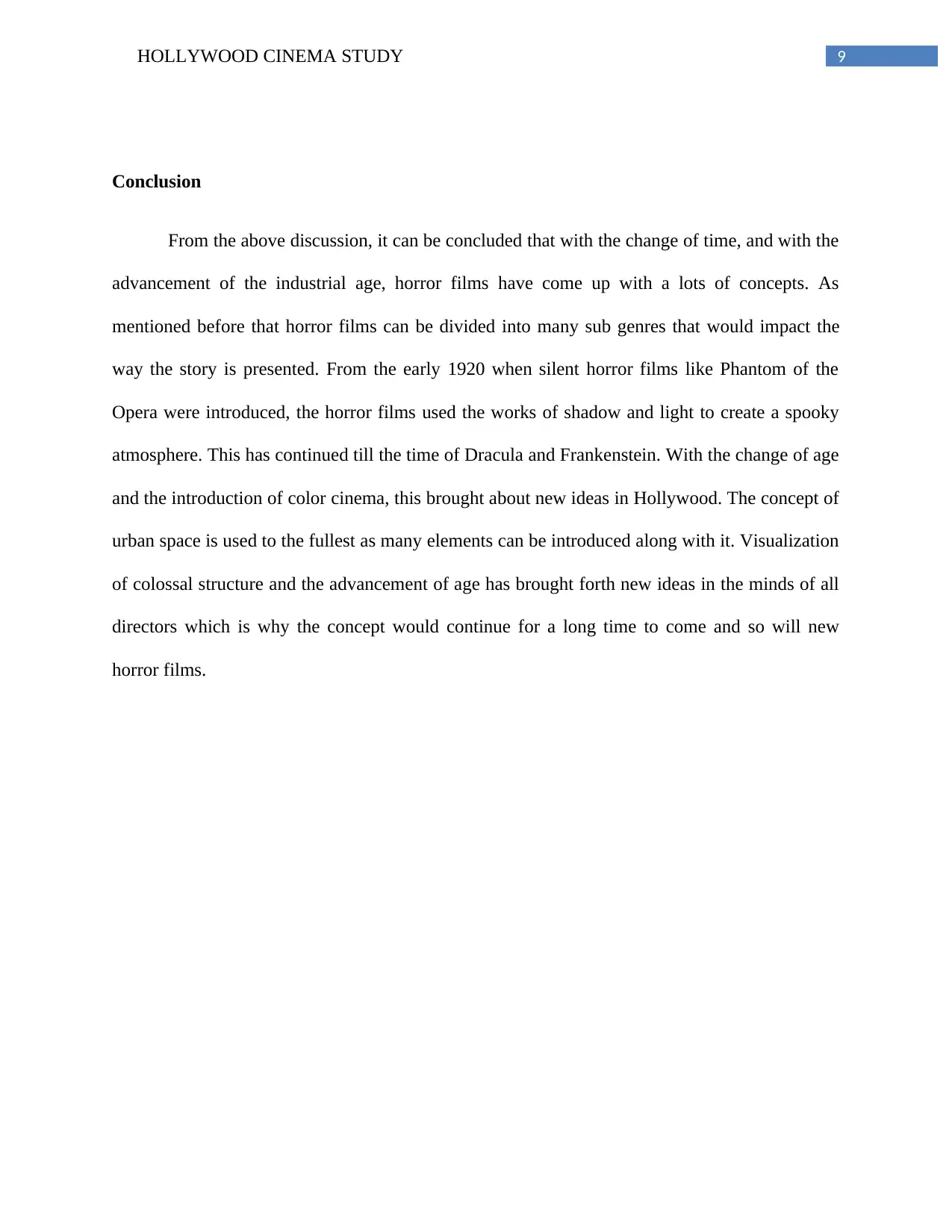
9HOLLYWOOD CINEMA STUDY
Conclusion
From the above discussion, it can be concluded that with the change of time, and with the
advancement of the industrial age, horror films have come up with a lots of concepts. As
mentioned before that horror films can be divided into many sub genres that would impact the
way the story is presented. From the early 1920 when silent horror films like Phantom of the
Opera were introduced, the horror films used the works of shadow and light to create a spooky
atmosphere. This has continued till the time of Dracula and Frankenstein. With the change of age
and the introduction of color cinema, this brought about new ideas in Hollywood. The concept of
urban space is used to the fullest as many elements can be introduced along with it. Visualization
of colossal structure and the advancement of age has brought forth new ideas in the minds of all
directors which is why the concept would continue for a long time to come and so will new
horror films.
Conclusion
From the above discussion, it can be concluded that with the change of time, and with the
advancement of the industrial age, horror films have come up with a lots of concepts. As
mentioned before that horror films can be divided into many sub genres that would impact the
way the story is presented. From the early 1920 when silent horror films like Phantom of the
Opera were introduced, the horror films used the works of shadow and light to create a spooky
atmosphere. This has continued till the time of Dracula and Frankenstein. With the change of age
and the introduction of color cinema, this brought about new ideas in Hollywood. The concept of
urban space is used to the fullest as many elements can be introduced along with it. Visualization
of colossal structure and the advancement of age has brought forth new ideas in the minds of all
directors which is why the concept would continue for a long time to come and so will new
horror films.
Secure Best Marks with AI Grader
Need help grading? Try our AI Grader for instant feedback on your assignments.
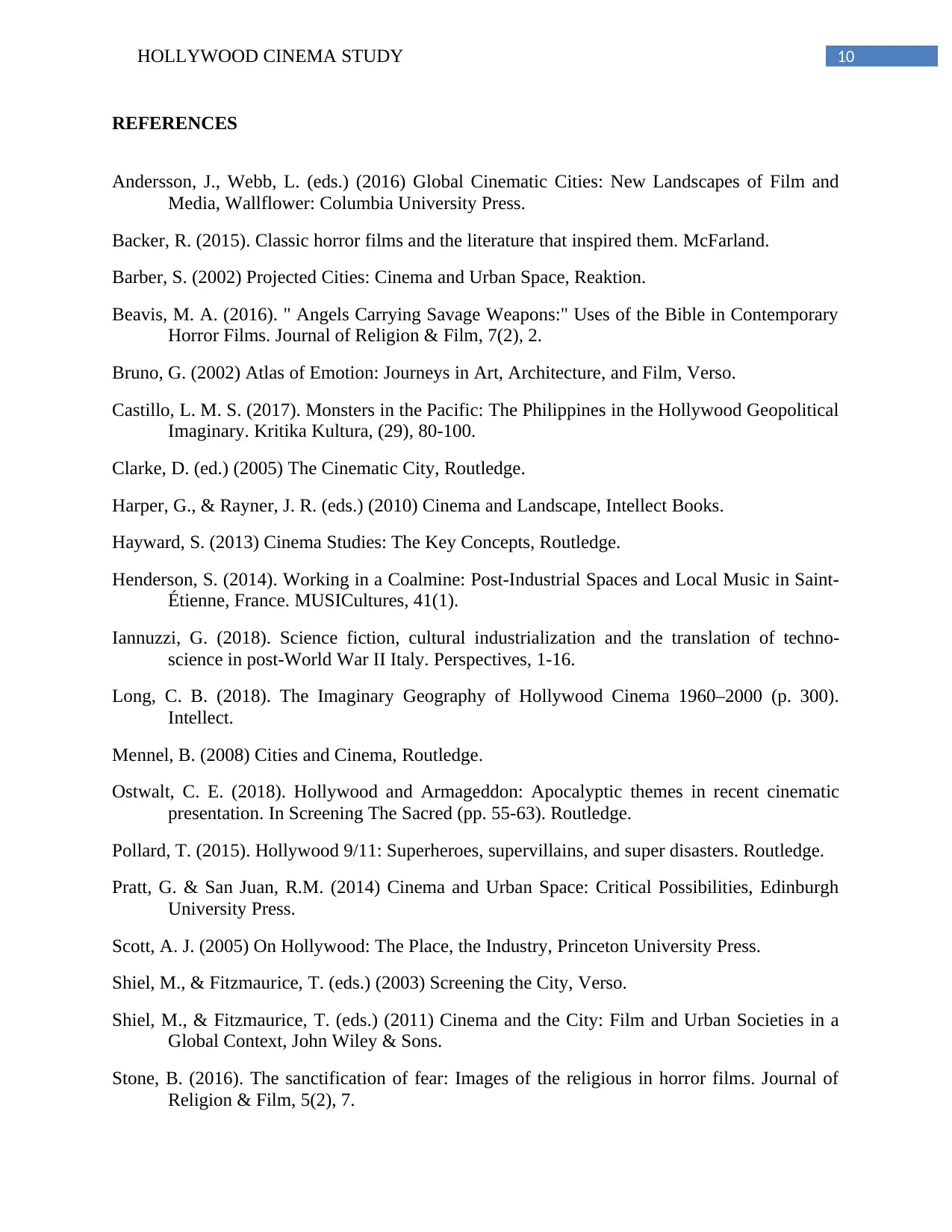
10HOLLYWOOD CINEMA STUDY
REFERENCES
Andersson, J., Webb, L. (eds.) (2016) Global Cinematic Cities: New Landscapes of Film and
Media, Wallflower: Columbia University Press.
Backer, R. (2015). Classic horror films and the literature that inspired them. McFarland.
Barber, S. (2002) Projected Cities: Cinema and Urban Space, Reaktion.
Beavis, M. A. (2016). " Angels Carrying Savage Weapons:" Uses of the Bible in Contemporary
Horror Films. Journal of Religion & Film, 7(2), 2.
Bruno, G. (2002) Atlas of Emotion: Journeys in Art, Architecture, and Film, Verso.
Castillo, L. M. S. (2017). Monsters in the Pacific: The Philippines in the Hollywood Geopolitical
Imaginary. Kritika Kultura, (29), 80-100.
Clarke, D. (ed.) (2005) The Cinematic City, Routledge.
Harper, G., & Rayner, J. R. (eds.) (2010) Cinema and Landscape, Intellect Books.
Hayward, S. (2013) Cinema Studies: The Key Concepts, Routledge.
Henderson, S. (2014). Working in a Coalmine: Post-Industrial Spaces and Local Music in Saint-
Étienne, France. MUSICultures, 41(1).
Iannuzzi, G. (2018). Science fiction, cultural industrialization and the translation of techno-
science in post-World War II Italy. Perspectives, 1-16.
Long, C. B. (2018). The Imaginary Geography of Hollywood Cinema 1960–2000 (p. 300).
Intellect.
Mennel, B. (2008) Cities and Cinema, Routledge.
Ostwalt, C. E. (2018). Hollywood and Armageddon: Apocalyptic themes in recent cinematic
presentation. In Screening The Sacred (pp. 55-63). Routledge.
Pollard, T. (2015). Hollywood 9/11: Superheroes, supervillains, and super disasters. Routledge.
Pratt, G. & San Juan, R.M. (2014) Cinema and Urban Space: Critical Possibilities, Edinburgh
University Press.
Scott, A. J. (2005) On Hollywood: The Place, the Industry, Princeton University Press.
Shiel, M., & Fitzmaurice, T. (eds.) (2003) Screening the City, Verso.
Shiel, M., & Fitzmaurice, T. (eds.) (2011) Cinema and the City: Film and Urban Societies in a
Global Context, John Wiley & Sons.
Stone, B. (2016). The sanctification of fear: Images of the religious in horror films. Journal of
Religion & Film, 5(2), 7.
REFERENCES
Andersson, J., Webb, L. (eds.) (2016) Global Cinematic Cities: New Landscapes of Film and
Media, Wallflower: Columbia University Press.
Backer, R. (2015). Classic horror films and the literature that inspired them. McFarland.
Barber, S. (2002) Projected Cities: Cinema and Urban Space, Reaktion.
Beavis, M. A. (2016). " Angels Carrying Savage Weapons:" Uses of the Bible in Contemporary
Horror Films. Journal of Religion & Film, 7(2), 2.
Bruno, G. (2002) Atlas of Emotion: Journeys in Art, Architecture, and Film, Verso.
Castillo, L. M. S. (2017). Monsters in the Pacific: The Philippines in the Hollywood Geopolitical
Imaginary. Kritika Kultura, (29), 80-100.
Clarke, D. (ed.) (2005) The Cinematic City, Routledge.
Harper, G., & Rayner, J. R. (eds.) (2010) Cinema and Landscape, Intellect Books.
Hayward, S. (2013) Cinema Studies: The Key Concepts, Routledge.
Henderson, S. (2014). Working in a Coalmine: Post-Industrial Spaces and Local Music in Saint-
Étienne, France. MUSICultures, 41(1).
Iannuzzi, G. (2018). Science fiction, cultural industrialization and the translation of techno-
science in post-World War II Italy. Perspectives, 1-16.
Long, C. B. (2018). The Imaginary Geography of Hollywood Cinema 1960–2000 (p. 300).
Intellect.
Mennel, B. (2008) Cities and Cinema, Routledge.
Ostwalt, C. E. (2018). Hollywood and Armageddon: Apocalyptic themes in recent cinematic
presentation. In Screening The Sacred (pp. 55-63). Routledge.
Pollard, T. (2015). Hollywood 9/11: Superheroes, supervillains, and super disasters. Routledge.
Pratt, G. & San Juan, R.M. (2014) Cinema and Urban Space: Critical Possibilities, Edinburgh
University Press.
Scott, A. J. (2005) On Hollywood: The Place, the Industry, Princeton University Press.
Shiel, M., & Fitzmaurice, T. (eds.) (2003) Screening the City, Verso.
Shiel, M., & Fitzmaurice, T. (eds.) (2011) Cinema and the City: Film and Urban Societies in a
Global Context, John Wiley & Sons.
Stone, B. (2016). The sanctification of fear: Images of the religious in horror films. Journal of
Religion & Film, 5(2), 7.

11HOLLYWOOD CINEMA STUDY
Su, W. (2014). Cultural policy and film industry as negotiation of power: The chinese state's role
and strategies in its engagement with global hollywood 1994–2012. Pacific Affairs,
87(1), 93-114.
Tompkins, J. (2014). The Cultural Politics of Horror Film Criticism. Popular Communication,
12(1), 32-47.
Trifan, E. (2015). Coaching and personal development: The construction of the self in a
community of practice in Bucharest. Romanian Journal of Society & Politics, 2, 119-132.
Webb, L. (2015) The Cinema of Urban Crisis: Seventies Film and the Reinvention of the City,
Amsterdam University Press.
Su, W. (2014). Cultural policy and film industry as negotiation of power: The chinese state's role
and strategies in its engagement with global hollywood 1994–2012. Pacific Affairs,
87(1), 93-114.
Tompkins, J. (2014). The Cultural Politics of Horror Film Criticism. Popular Communication,
12(1), 32-47.
Trifan, E. (2015). Coaching and personal development: The construction of the self in a
community of practice in Bucharest. Romanian Journal of Society & Politics, 2, 119-132.
Webb, L. (2015) The Cinema of Urban Crisis: Seventies Film and the Reinvention of the City,
Amsterdam University Press.
1 out of 12
Related Documents
Your All-in-One AI-Powered Toolkit for Academic Success.
+13062052269
info@desklib.com
Available 24*7 on WhatsApp / Email
![[object Object]](/_next/static/media/star-bottom.7253800d.svg)
Unlock your academic potential
© 2024 | Zucol Services PVT LTD | All rights reserved.



